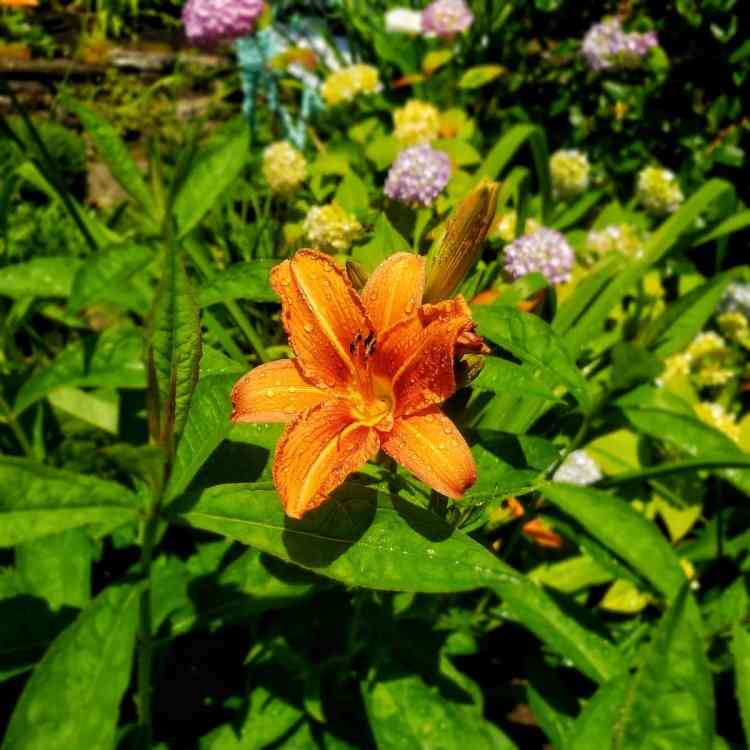
By Julie Christensen
Daylilies (Hemerocallis) are among the most beautiful, low-maintenance perennials you can grow in the garden. Native to Asia, daylilies have naturalized throughout the U.S., and are often seen growing wild along ditches in both full sun and partial shade. Note that daylilies and true lilies (Lillium) are two different types of flowers.
Old varieties of daylily flowers, including ‘Europa’ and the classic ‘Stella de Oro’ are worth growing, but don’t forget new hybrids. Today, daylilies come in a wide variety of hues, from deep red, orange and pink to lavender and white. Daylilies come in dwarf varieties, and may also have fringed, curled or ruffled blooms. New tetraploid hybrids have larger, more extravagant flowers. In the south, try evergreen or semi-evergreen types that stay green most of the year.

Hermocallis means “beautiful for a day,” and refers to the fact that the flowers generally bloom for one day only before closing. Don’t let this discourage you. One stem produces multiple flowers that open over a period of several weeks. Daylilies bloom from early summer through fall, depending on the cultivar and some varieties are rebloomers.
Planting and Caring for Daylilies
Daylilies grow from tuberous rhizomes. From these rhizomes form a spreading mound of bright green, strap-like foliage. Atop the leaves appear tall stems with multiple flowering branches. Plant daylilies from nursery plants or divisions in late summer to fall. You can also plant them in the spring, although flowering will be diminished during the first season.
Daylilies tolerate most soils, including alkaline and slightly acidic soils, but they do need good drainage. Overly rich soils can encourage leafy growth instead of flowering. Amend the soil with compost or manure to improve drainage and texture. Dig holes as deep as the roots and twice as wide. Make a slight ridge of soil in the middle of the holes. Set the daylily plants so their roots rest on either side of the ridge. The crowns of the plants – which are where the leaves meet the roots – should sit no more than 1 inch beneath the soil surface. Firm the soil gently around the plants and water the soil well.
Daylilies have a reputation for being drought tolerant and they do withstand dry conditions. However, they’ll bloom better if they get weekly moisture. Fertilize daylilies in the spring with 1 tablespoon of 0-10-10 fertilizer. Don’t overfertilize, though, which will reduce blooms.
Snip the stems back after the plants have flowered to remove the flower bracts. If allowed to go to seed, you’ll notice less flowering the next season. Divide daylilies every 5 to 7 years, as flowering and growth slows. To divide them, cut the leaves back to 8 to 10 inches. Use a shovel or garden fork to dig around the entire plant. Lift it out of the ground. Divide the plant with a sharp knife into several pieces. Replant the pieces. At some point, you’ll probably have more daylilies than you know what to do with. Share leftovers with friends and neighbors.
Potential Pests and Problems
Daylilies rarely suffer from disease or pest problems. In humid climates, you may notice daylily leaf streak. Rotting may occur in heavy, sodden soils. Aphids, mites, snails and slugs are the most common insect pests, but they rarely cause significant damage. Treat aphids and mites with insecticidal oils or soaps. To combat slugs and snails, pull away any mulch and allow the ground to dry out. Set snail traps if necessary.
Sometimes, the main problem with daylilies is their vigorous growth. If you decide to move or replace daylilies, be sure to dig out every last rhizome. Even then, small bits may remain and you may find yourself pulling out daylilies for a few years before you finally eradicate them.
Varieties of Daylily Flowers Worth Trying
There are hundreds of daylily cultivars on the market today. Choose varieties adapted to your region and pay attention to the mature size of the plant. Dwarf varieties make excellent borders. Larger cultivars are attractive at the back of the garden. Plant several cultivars to extend the bloom season.
- ‘Always Afternoon’ has lovely lavender flowers that bloom in mid-summer. Semi-evergreen.
- ‘Happy Returns’ produces lemon yellow flowers predictably from early summer to frost.
- ‘Kwanso’ produces double orange flowers.
- ‘Pardon Me’ is a mid-season bloomer that produces fragrant red blooms.
To learn more about daylilies, visit the following links:
Daylily from Clemson Cooperative Extension
Growing Daylilies from the University of Vermont Extension
Better Homes and Gardens covers the basics of daylily flower care on YouTube.
And don’t forget that day lily buds are delicious! With the consistency of green beans, and the flavor a cross between asparagus and artichoke, they are wonderful in stir fries, or alone with a little butter, salt and pepper. Use in salads, too. Pick when still tightly closed, about an inch and a half long, up until they are just about to open.